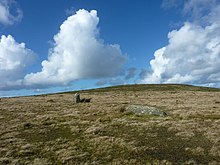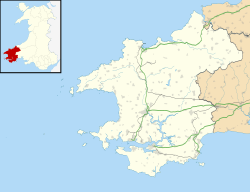Waun Mawn
 Standing stone and prostrate stone near Cnwc yr Hŷdd, Waun Mawn in October 2012 | |
 Shown within Pembrokeshire | |
| Location | Near Tafarn y Bwlch, Brynberian, Pembrokeshire, Wales |
|---|---|
| Coordinates | 51°58′18″N 4°47′28″W / 51.9716°N 4.7912°WCoordinates: 51°58′18″N 4°47′28″W / 51.9716°N 4.7912°W |
| Type | Stone circle site |
| History | |
| Periods | Neolithic |
| Site notes | |
| Archaeologists | Mike Parker Pearson |
Waun Mawn (Welsh for "peat moor") is the site of a possible dismantled Neolithic stone circle in the Preseli Hills of Pembrokeshire, Wales. The diameter of the postulated circle is estimated to be 360 feet (110 m), the third largest diameter for a British stone circle.[1][2]
The site is located at grid reference SN08393403 around 1 mile (1.6 km) to the south west of Brynberian.[3] This tract of moorland sits on the southern slopes of the 1,112 feet (339 m) hill top of Cnwc yr Hŷdd, just to the north of the broad east-west ridge of the Preseli range.[4]
There are four remaining stones, one standing and three prostrate. Nearby are the "Troed y Rhiw" standing stones and to the west of the main group is another solitary standing stone, the 'Waun Mawn Stone', measuring some 7 ft 7 in (2.3 m) high.[5]
Recent findings
During 2017 and 2018, excavations by the UCL team of archaeologist Mike Parker Pearson, led to a proposal that the site had originally housed a 110-metre (360 ft) diameter stone circle of the same size as the ditch at Stonehenge[6][7] The archaeologists also postulated that the circle also contained a hole from one stone which had a distinctive pentagonal shape, very closely matching the one pentagonal stone at Stonehenge (stonehole 91 at Waun Mawn/stone 62 at Stonehenge).[6][7] Both circles appear, according to some researchers, to be oriented towards the midsummer solstice.[6]
Following soil dating of the sediments within the postulated stone holes, via optically stimulated luminescence (OSL), it has been argued, by Parker Pearson, that the circle of stones was built c. 3400–3200 BC and then, before 2120 BC, was disassembled, dragged across land and reassembled at Stonehenge in Wiltshire, some 140 miles (230 km) distant.[8] Parker Pearson's proposals have been published in the journal Antiquity.[1] This postulated migration of the stones was likened by the researchers to the story told by Geoffrey of Monmouth, in his 12th-century History of the Kings of Britain, of Merlin taking the stones of the Giant's Dance circle in Ireland to Stonehenge.[6]
The site and its connection with Stonehenge was the subject of the BBC Two programme, Stonehenge: The Lost Circle Revealed, with Parker Pearson and Professor Alice Roberts. Broadcast was on 12 February 2021,[1][6][9][10] and reported in New Scientist on 20 February 2021.[11]
References
- ^ a b c Pearson, Mike Parker; Pollard, Josh; Richards, Colin; Welham, Kate; Kinnaird, Timothy; Shaw, Dave; Simmons, Ellen; Stanford, Adam; Bevins, Richard; Ixer, Rob; Ruggles, Clive; Rylatt, Jim; Edinborough, Kevan (February 2021). "The original Stonehenge? A dismantled stone circle in the Preseli Hills of west Wales". Antiquity. 95 (379): 85–103. doi:10.15184/aqy.2020.239. Retrieved 19 February 2021.
- ^ An Inventory of the Ancient Monuments of Wales and Monmouthshire, Vol.VII. Royal Commission. 1925. p. 260.
- ^ "Waun Mawn (300423)". Coflein. RCAHMW. Retrieved 12 February 2021.
- ^ OL35 North Pembrokeshire [Gogledd Sir Benfro] (Map) (A1bar ed.). 1:25,000. Explorer. Ordnance Survey. 2002. ISBN 9780319236239.
- ^ "Waun Mawn Standing Stones, Pembrokeshire: Photos & Visiting Information". Britain Express. Retrieved 13 February 2021.
- ^ a b c d e Pearson, Mike Parker; Pollard, Josh; Richards, Colin; Welham, Kate; Kinnaird, Timothy; Shaw, Dave; Simmons, Ellen; Stanford, Adam; Bevins, Richard; Ixer, Rob; Ruggles, Clive; Rylatt, Jim; Edinborough, Kevan (February 2021). "The original Stonehenge? A dismantled stone circle in the Preseli Hills of west Wales". Antiquity. 95 (379): 85–103. doi:10.15184/aqy.2020.239. Retrieved 19 February 2021.
- ^ a b England’s Stonehenge was erected in Wales first
- ^ "Stonehenge: Did the stone circle originally stand in Wales?". BBC News. 12 February 2021. Retrieved 12 February 2021.
- ^ "Stonehenge: The Lost Circle Revealed". BBC Two. 12 February 2021. Archived from the original on 12 February 2021. Retrieved 19 February 2021.
- ^ Pearson, Mike Parker; Bevins, Richard; Ixer, Rob; Pollard, Joshua; Richards, Colin; Welham, Kate; Chan, Ben; Edinborough, Kevan; Hamilton, Derek; Macphail, Richard; Schlee, Duncan; Schwenninger, Jean-Luc; Simmons, Ellen; Smith, Martin (December 2015). "Craig Rhos-y-felin: a Welsh bluestone megalith quarry for Stonehenge". Antiquity. 89 (348): 1331–1352. doi:10.15184/aqy.2015.177. Retrieved 19 February 2021.
- ^ George, Alison (20 February 2021). "Stonehenge may be a recycled Welsh structure". New Scientist. p. 16.
External links
- Standing stone at Waun Mawn from geograph.org.uk
- Waun Mawn (Tafarn y Bwlch) at megalithic.co.uk, updated 2018
- Stone circles in Wales
- Monuments and memorials in Pembrokeshire
